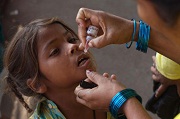
World Polio Day is on October 24, and we are closer than ever to eradicating this life threatening and crippling disease. The number of cases is at a historic low. We have a once-in-a-generation opportunity to ensure that no child has to suffer from it again.
The fight against polio is important to me, and not just because it is a terrible disease that kills and maims children. For me, it’s personal: I survived polio. In fact, millions of children in India contracted polio in the not-so-distant past and were forced into lives of infirmity and despondency because of poverty, ignorance, and poor access to health services.
But for the first time since its independence, India is polio free—a tribute to the government, international and national partners, and, most importantly, the health workers who made sure that they reached every child.
However, the threat has not passed. Countless children in Afghanistan, Pakistan and Nigeria—the three countries where polio still exists—suffer the consequences of this awful disease. This disease, like many others, can migrate across borders, and left unchecked, will resurface in neighboring and distant countries.
In addition to logistics and access issues, conflict and insecurity problems in Afghanistan, Pakistan, and Nigeria have presented challenges to polio immunization, and this has often been the focus of media coverage about polio eradication efforts. To be sure, those problems are real. We have seen them affect eradication efforts in North and South Waziristan, Pakistan and northern Nigeria.
However, these are surmountable obstacles. Over the past 20 years, we have seen polio defeated in some of the most challenging, impoverished, and insecure parts of Sudan, Somalia, El Salvador, Colombia, and many parts of India. I have seen firsthand that it is possible to immunize all children in the midst of the conflict in Darfur in 2004. Millions of children have received polio vaccines in countries ravaged by conflict and poverty, thanks to determined action by national governments and the work of courageous health workers from UNICEF, WHO, Red Cross-Red Crescent National Societies, and NGOs. Without the perseverance, commitment and generosity of international partners like GAVI, Rotary International, the Gates Foundation, UK’s DFID, and the US Center for Disease Control, we would not have made it this far.
The humanitarian imperative combined with political will must continue to guide the partnerships and innovative strategies needed to make this final push. Today, we are seeing results in the remaining endemic countries. Just last month, as a result of Pakistan’s National Emergency Action Plan and the hard work of local vaccinator teams, more than 32,000 children in Bara and Tirah Valley received polio vaccines for the first time since 2009, and many received measles and pentavalent vaccines for the first time ever.
In southern Afghanistan, talks with the Quetta Shura Taliban have allowed health workers to enter previously inaccessible areas. Nigeria, too, is making enormous progress in its 11 high-risk polio states. With leadership and accountability at every level of government, we can achieve success in areas of peace or conflict. Nigeria and Afghanistan have also been implementing new national emergency plans, a clear demonstration that they are invested in stamping out polio.
I was thrilled to see the global solidarity at the UN General Assembly in September 2012 when UN Secretary-General Ban Ki-moon spoke loudly and passionately to end polio together with the presidents of Pakistan, Afghanistan and Nigeria. Key donors such as the Gates Foundation, Rotary International, UK, US, Australia along with UNICEF’s Tony Lake and WHO’s Margaret Chan joined to renew their commitment to end polio forever. We are seeing new partners like the Islamic Development Bank join the fight against polio.
The global community must focus on overcoming the largest obstacle standing in the way of defeating polio. We must ensure the effort is fully funded; not just year-by-year, but for the long term. A funding gap earlier this year led to cancelled and scaled-back vaccination campaigns in 24 high-risk countries, leaving children vulnerable to polio. Unless the global polio program is fully funded, we risk polio making a comeback in countries that are polio free. That would be a catastrophe.
From 125 countries in 1988 to three remaining countries, we are in the last mile. We have the opportunity to ensure success, and we must not fail to deliver a legacy of a polio-free world. With resolve and a shared sense of responsibility and commitment, polio can go the way of smallpox —complete eradication. This is the greatest gift we can give to every child in the world, and a gift to humanity itself.
Siddharth Chatterjee is the Chief Diplomat and Head of Strategic Partnerships and International Relations at the International Federation of the Red Cross and Red Crescent Societies. His e mail address is: sidc@alumni.princeton.edu. Twitter: sidchat1
A girl receives an oral polio vaccine from a health team member at the railway station in Patna, in the state of Bihar, India. © UNICEF/NYHQ2006-2655/Tom Pietrasik




